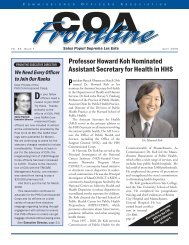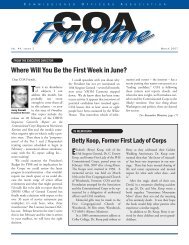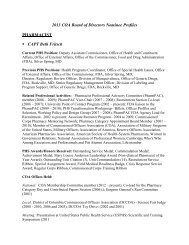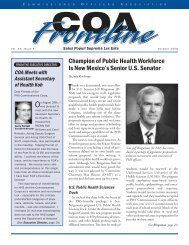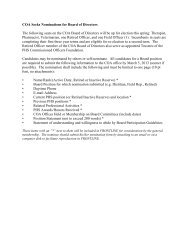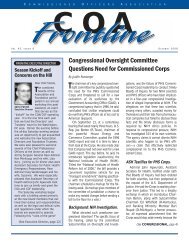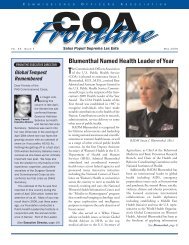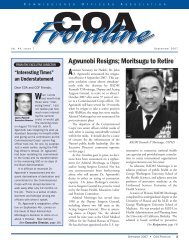February 2005 Frontline - Commissioned Officers Association
February 2005 Frontline - Commissioned Officers Association
February 2005 Frontline - Commissioned Officers Association
Create successful ePaper yourself
Turn your PDF publications into a flip-book with our unique Google optimized e-Paper software.
funded.<br />
This all relates back to the stalled<br />
issue of transforming the Corps. If the<br />
Corps’ mission (still not ready for<br />
release) is to include emergency<br />
response (which, according to the NRP<br />
it surely does), then the requirements<br />
necessary to fulfill that mission must<br />
be identified and apportioned (they are<br />
neither identified nor apportioned).<br />
The Corps must be organized in such<br />
a way as to be able to fulfill the<br />
mission. Emergency response<br />
demands centrally managed and operated<br />
organizational constructs with<br />
clear lines of authority, chains of<br />
command, and – oh yes – accountability.<br />
If we are serious about doing<br />
this right, then the OSG will have to<br />
have a budget and billets sufficient to<br />
meet assigned responsibilities and<br />
requirements as defined by the<br />
mission. COA has previously proposed<br />
the creation of a designated team of<br />
officers funded through OSG and<br />
assigned to the states that would be<br />
part of a rapid response to any event –<br />
domestically or internationally. If<br />
that entity existed, then requirements<br />
outlined above would all come<br />
together – chain of command, clear<br />
lines of authority, and accountability.<br />
Also the magic requirement of<br />
funding would be resolved. When the<br />
event exceeded the capacity of that<br />
designated team, OFRD could then dip<br />
into the rest of the <strong>Commissioned</strong><br />
Corps for augmentation. We have to<br />
believe the OpDivs and agencies would<br />
applaud this structure, in that it would<br />
significantly reduce the almost<br />
constant requests to deploy their<br />
officers.<br />
ESF #8 is a confusing and disorienting<br />
mishmash of overlapping<br />
responsibility, unclear authority,<br />
confused chains of command and no<br />
apparent accountability. Word is that<br />
no one is particularly happy with it –<br />
the folks in Homeland Security are<br />
uncomfortable and the folks in DHHS<br />
ought to be. Thus far, we have had<br />
success following disasters because of<br />
the awesome dedication and professionalism<br />
of individuals who make a<br />
seriously flawed system work. We can<br />
only hope that the system will get<br />
fixed before we really need it.<br />
BOTC Held in Fort Worth, Texas<br />
The Federal Bureau of Prisons<br />
Health Services Division and the<br />
Federal Medical Center, Carswell<br />
sponsored a Basic Officer Training<br />
Course (BOTC) in Fort Worth, Texas,<br />
November 30-December 2, 2004 at<br />
the Naval Air Station, Joint Reserve<br />
Base. The <strong>Commissioned</strong> <strong>Officers</strong><br />
Training Academy staff, CDR Meta<br />
Timmons and LT Carolyn Oyster,<br />
presented a thorough and professional<br />
course. Federal Medical Center<br />
(FMC) Carswell Warden, Ginny Van<br />
Buren, presented opening and closing<br />
remarks.<br />
Seventy-two officers participated<br />
in this training. Although most of<br />
the officers were from Texas, officers<br />
came from North Carolina, Washington<br />
DC, New York, Louisiana, Illinois,<br />
Oklahoma, Maryland, Arizona, and<br />
Kansas. The officers were of all ranks<br />
and disciplines and are assigned to<br />
the Federal Bureau of Prisons, Food<br />
and Drug Administration, Centers<br />
for Medicare and Medicaid Services,<br />
Indian Health Service, and Health<br />
Resources and Services<br />
Administration.<br />
The Fort Worth Chapter of the<br />
<strong>Commissioned</strong> <strong>Officers</strong> <strong>Association</strong><br />
(COA) provided assistance for the<br />
training, including a social event at<br />
the Fort Worth Stockyards. Texas<br />
hospitality was alive and well<br />
throughout the training. The BOTC<br />
instructors were given a tour of the<br />
FMC, Carswell by the BOTC<br />
Coordinator, CAPT Julia Dunaway.<br />
The day of the tour happened to<br />
occur during the annual Christmas<br />
tree lighting ceremony. CDR<br />
Timmons was surprised to see three<br />
inmate choirs singing to the large<br />
assembly of inmates and staff.<br />
CAPT Newton Kendig, BOP<br />
Medical Director, who was unable to<br />
attend, asked CAPT Nick Makrides,<br />
BOP Chief Dentist, and one of the<br />
class participants, to speak on his<br />
behalf regarding transformation of<br />
the corps and the recent personnel<br />
policy changes. Mr. Scott Murchie,<br />
BOP Health Services Division, Chief<br />
of Staffing and Recruitment, also<br />
attended the first two days of the<br />
BOTC.<br />
The Texas officers were extremely<br />
grateful to have a BOTC class close<br />
to home, learn about PHS history<br />
and policy, and especially to meet<br />
new friends.<br />
Participants in the Basic Officer Training Course, November 30-December 2,<br />
2004, in Fort Worth, Texas<br />
COA FRONTLINE • FEBRUARY <strong>2005</strong> 25



